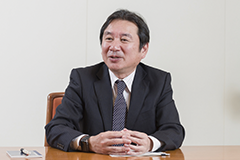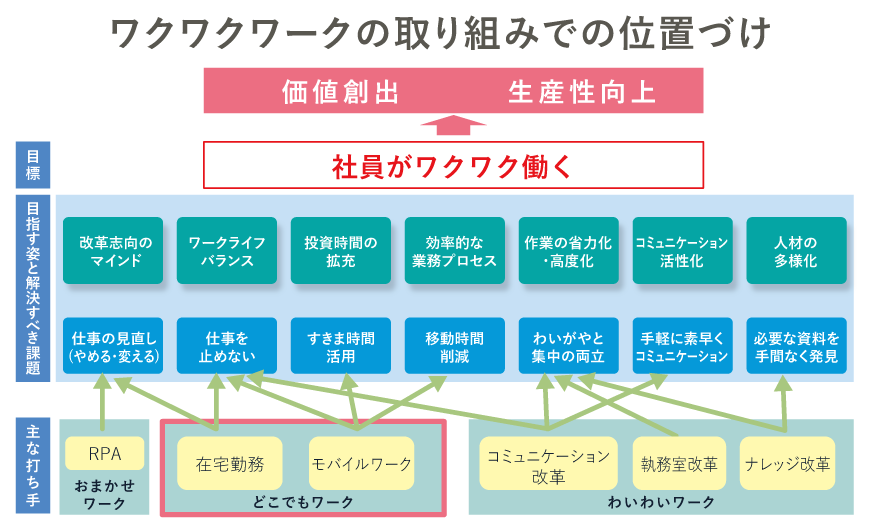Tokyo Gas Co.
Promoting ICT-enabled work style and business process reforms
By introducing the “Styleflow” workflow system,
“Work Anywhere” for application, approval, and decision-making operations has been realized.
Introduction points
- Decided to electronically approve superior reports as part of work style reforms.
- Provide implementation support tailored to customer expectations (training, robot implementation, support, etc.)
- System construction know-how from 62 years in business (independent system integrator)
Interviewee

Background and Current Issues
Promoting business model transformation in line with energy deregulation
Tokyo Gas provides city gas, a major lifeline, to Tokyo and six prefectures including adjacent areas. The company is aggressively promoting its integrated energy business in light of the full deregulation of electricity in April 2016 and city gas in April 2017. Kazumasa Sawada, General Manager of the IT Generalization Department, explains the key points as follows.
In the energy business, it is very difficult to differentiate ourselves from our competitors. That is why we need to strengthen our services and globalization in the future. And the most important management resource for achieving this is human resources. In this sense, it is no exaggeration to say that the transformation of our business model is an integral part of the reform of the way we work.”
The “Exciting Work” project to reform work styles promoted by ICT
As part of this “reform of work styles,” the company has been working on a project called “Exciting Work” utilizing ICT since FY2016. The project is meant to “increase value (increase value provided),” “respond to change (respond to changes in the business environment),” and “enjoy working (foster a new mindset and culture).
The project consists of three components: “Anywhere Work,” which eliminates restrictions on working locations through telecommuting and mobile work, “Waiwai Work,” which reforms communication, the office, and knowledge, and “Omakase Work,” which uses AI and RPA (work automation by robots). The “Wai-Wai Work” program is designed to reform the knowledge of the employees and to improve their productivity. Of these, “Anywhere Work,” which directly contributes to improving employee productivity, is now in the full-scale implementation stage.
One of the tools adopted for the “electronic approval of applications” is Styleflow, a cloud-based workflow system that enables paper-based applications, approvals, and decisions to be made from anywhere. Trial operations began in March 2017 with the aim of speeding up approvals and improving productivity. Based on solid verification, the system has been in operation company-wide since April 16, 2018.

Workflow functionality is also used in "work style reform
Styleflow Enables “Work Anywhere” Promotion
The workflow system has been positioned as a measure to (1) visualize operations, (2) speed up decision-making, (3) strengthen compliance, (4) reduce the risk of loss, and (5) reduce costs associated with the paperless system. In addition, the company has positioned it as a major tool for “work style reform.
The main goal of work style reform is to improve productivity. We believe that by pursuing a variety of work styles and eliminating wasteful and unreasonable time, each individual can focus on his or her primary job. For example, if you are a sales representative, you are supposed to devote your time to your customers. However, when we actually measured the amount of time spent on this, we found that it was surprisingly small. One of the reasons for this was the work involved in the application process. Until now, the time spent on application work has been limited by the need to return to the office to obtain a seal or the absence of the supervisor, which sometimes delayed the decision-making process. We decided to introduce Styleflow because we felt that this would hinder our “work anywhere” philosophy. (Mr. Sawada, General Manager)
Easy design and creation of approval routes by applicants themselves
In making the selection, we compared and examined four products. As a result, “Styleflow” was selected because it is mobile-compatible for both applications and approvals, allows applicants to easily design and create their own approval routes, can be quickly introduced as a SaaS service, and leads to reduced TCO. The vendor’s reliability and ability to make proposals were also advantages.
In addition, the actual operation of the system is intended to digitize non-routine applications and approvals, such as purchases other than the usual consumables and contract applications, which require a request for approval.
Atypical applications and approvals are difficult to systematize because the workload is high, as it is done on a case-by-case basis. That is why it is so important for us to be able to offer a service that allows each individual to create his or her own approval route for each case. (Director Sawada)
Solid response to the effects of the trial operation
The trial operation, conducted mainly by the General Affairs Department, which is in charge of application rules, the IT Department, which is a key section in the system implementation, and the Sales Department, which handles a large number of applications, has yielded positive results. According to the results of the questionnaire, more than 40% of the users felt that “the time required to complete the approval process has been shortened,” and 70% of the users answered that “the management of paper documents and the risk of losing them” have been reduced. The trial was only for a limited environment. When the entire company can cross-departmentalize the system, it will be possible to overcome not only the time barrier, but also the distance between offices and the headquarters, so the evaluation will be even higher. The company is also looking ahead to the future.
In addition, as part of the company’s “work style reform,” “reduction of overtime” is one of the important themes, and the company-wide introduction of “Styleflow” is expected to play a role in spurring this effort. Incidentally, the reduction of overtime hours is not just a matter of shortening working hours, but is also linked to the reduction of originality and ingenuity in the workplace, as well as to the reduction of tasks that have become idiosyncratic to each individual employee. If “Work Anywhere” is expanded through “Styleflow,” it will also contribute to the improvement of work-life balance, allowing employees to choose and realize various ways of living and working according to each stage after joining the company.
Future Challenges and Prospects
Top priority is retention As a measure to support diverse work styles
Regarding the future development of workflow, General Manager Sawada emphasizes, “It is important to make it take root in the company. To this end, upon company-wide introduction, the company is implementing detailed follow-up, including training of department leaders, holding user briefings, setting up an in-house help desk, holding events to introduce the tool using the cafeteria, and providing announcements and explanations on the company portal.
The company began introducing a telecommuting system and expanding satellite offices in FY2017, and more than 350 employees have already applied to use mobile devices. In doing so,” Styleflow “will undoubtedly become an effective tool to promote the company’s teleworking and support diversity based on” productivity improvement,“which has been set as the most important goal in the” reform of work styles.
Company Information
Tokyo Gas Co.
Founded in 1885, the company has been operating in the Tokyo metropolitan area for more than 130 years and is Japan's largest city gas utility. 1969 saw the introduction of Japan's first liquefied natural gas (LNG). The “Challenge 2020 Vision,” formulated and announced in 2011, calls for further advancement of the LNG value chain as “a pioneer in LNG and a top runner in natural gas,” while promoting integrated energy and globalization. As a “pioneer of LNG and a top runner in natural gas”, the company is working to further advance the LNG value chain and promote integrated energy and globalization.
- Establishment
- October 1, 1885
- Location
- 5-20, Kaigan 1-chome, Minato-ku, Tokyo
- Home page
- http://www.tokyo-gas.co.jp/
- Industry
- Energy
- Employee size
- More than 5,000
-
This case study is based on interviews conducted in April 2018. Data, organization names, and positions in the article are current at the time of the interview.
-
All company and service names mentioned herein are trademarks or registered trademarks of their respective companies.
